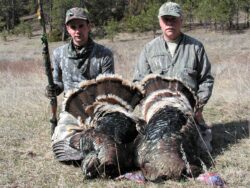 Turkey time is a special time to be in the woods. Hunting gobblers at sunrise is one of the most incredible and exciting hunts.
Turkey time is a special time to be in the woods. Hunting gobblers at sunrise is one of the most incredible and exciting hunts.
When early settlers came to the New World, turkeys were abundant. The native people depended on them for food. Deer were less common than the large and common flocks of turkeys. Large, mature forests are the perfect habitat for turkeys. They can roost in safety amongst the high branches. Abundant mast crops provided the birds with chestnuts, acorns, and other seeds. Mature woods were also more open which allows birds to see more clearly.
Deer are critters of edges where fields meet forests. A squirrel could have jumped from tree to tree, from the Atlantic Ocean to the Mississippi River, before the Europeans arrived. Once the new settlers began felling trees, turkey habitat was lost, and deer habitat improved. Eventually, over timbering was the downfall for both critters and many more. Without trees, erosion, shelter, and food were lost. Deer and turkey sightings became rare.
Thankfully, sportsmen and wildlife/ habitat mangers began to protect and conserve our special wildlife and lands. Hunting seasons were created. Limits were established, and public lands were created and protected. Funds from licenses and special taxes on outdoor gear funded this amazing transformation. Using trapping and transport, turkeys have been introduced throughout the United States.
Today turkeys can be found in every state in America. There are several different species that have adapted to their unique habitats from swamps to deserts. Soth America is also home to a variety of these unique birds.
Spring is mating time for turkeys. The Gobblers hand near the groups of hens. A ritual of calling, dancing, and strutting precedes mating. Their plumage is iridescent and unique.
Gobblers gobble and compete for dominance. Like other critters, males fight for their mates. They use their powerful spurs, beaks, and wings to fight competition. I have seen 2-4 gobblers engaging in battle at the same time. The battlefield was covered in blood and feathers after the fight was over.
Turkeys mate violently. The male forces the hen to the ground and stomps her while mating. Gobblers are birds and do not have a penis. Instead, they use an opening called the” Cloaca”. The male presses their cloaca against the female and gives the “Cloacal Kiss”. Sperm is shot gunned into the female.
The more compliant the female, the more successful the mating. Hens only need to mate once to produce a litter of 12-20 eggs. She lays her eggs standing up and some eggs become broken. This attracts predators and insects. If the nest is lost, she will create a new nest and start over. Hens are also known to willingly accept other young chicks into their flocks. I once watched a single adult hen walk by me with over 40 chicks in tow.
Merriam Gobblers have not always been abundant in Montana and a harsh Winter can really knock their populations down. Pioneers brought turkeys along and some made it into the wild. Later turkeys were stocked in Big Sky Country. Eastern birds were released in northwest MT and have thrived.
Humans are not the only hunters that pursue turkeys. All predators will eat turkeys. The Great Horned owl has a taste for owls. Coyotes, raptors, wolves, foxes, feral pigs, panthers, and most meat eaters welcome a turkey dinner. Flocks are safer when together. Many eyes and ears can spot trouble coming.
Tagging a Spring Gobbler is not easy. The hunter must be proficient at scouting, calling, camouflage, stealth, and shooting. Plenty of luck is also needed. Turkeys have great vision and hearing. Hunters are in their living rooms when on the hunt. Turkeys notice everything about their surroundings and easily avoid many dangerous encounters.
Gobble, gobble, cluck, cluck!
Montana Grant
